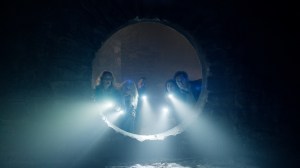Zack Snyder’s Justice League is finally here and while the film, which is streaming on HBO Max, has given viewers a completely different film than the theatrical release of Justice League, it’s also come with a surprise that isn’t exactly story-related. The film has a different aspect ratio than one might expect, with the film even coming with a notice that reads “This film is presented in a 4:3 format to preserver the integrity of Zack Snyder‘s creative vision.” As viewers soon noticed, the film has a more square look with black bars on the sides of the film as opposed to the widescreen view with black bars at the top and bottom that most films have. If you’re wondering what the difference is and why the Snyder Cut is in that square format, here’s an explainer.
Videos by ComicBook.com
The 4:3 format, also known as a 1.33:1 aspect ratio, is the format in which Snyder filmed Justice League on 35mm film. This is a bit different from the 1.85:1 aspect ratio that most theatrical films are shot in and what that means is that the Snyder Cut offers a more vertical viewing landscape as opposed to a more horizontal one. To put it more plainly, you see more at the top and bottom than you would a more standard aspect ratio.
It’s a pretty big difference in terms of what the audience sees. It’s also the aspect ratio for IMAX screens, and it’s Snyder’s original intention for Justice League to screen on IMAX that is part of why the Snyder Cut is in that “boxy” format.
“My intent was to have the movie, the entire film, play in a gigantic 4:3 aspect ratio on a giant IMAX screen,” Snyder explained last year at JusticeCon. “Superheroes tend to be, as figures, they tend to be less horizontal. Maybe Superman when he’s flying, but when he’s standing, he’s more of a vertical. Everything is composed and shot that way, and a lot of the restoration is sort of trying to put that back. Put these big squares back… it’s a completely different aesthetic. It’s just got a different quality and one that is unusual. No one’s doing that.”
Snyder also spoke previously about how a lot of the work preparing the Snyder Cut involved restoring that aspect ratio as the theatrical release utilized the 1.85:1 aspect ratio.
“Everything’s composed and shot that way, and a lot of the restoration is sort of trying to put that back,” Snyder said. “A lot of the work we’re doing is trying to restore the full frame. It’s like literally a restoration project at this point, because there were certain scenes that were just fucked up by the crop, so we have to kind of like fix it, a little bit.”
Ultimately, while the more “boxy” format is a bit jarring for viewers more accustomed to the standard widescreen format, the presentation of Zack Snyder’s Justice League in 4:3 is just another detail that restores how Snyder intended the film to be seen. Snyder also hopes that fans will someday be able to see the film on the actual big screen.
“I’ve said this, it is my ideal and deep dream and hope that we will be able to screen this movie for fans in IMAX,” Snyder told Ping Pong Fix. “Whether it be once or a hundred times I’m not sure, but that is really what I would love to see….It would be after, we would release the movie on HBO Max and then we would take those dedicated few to the big, big, big screen and just go nuts.”
Zack Snyder’s Justice League is now available to stream exclusively on HBO Max.








